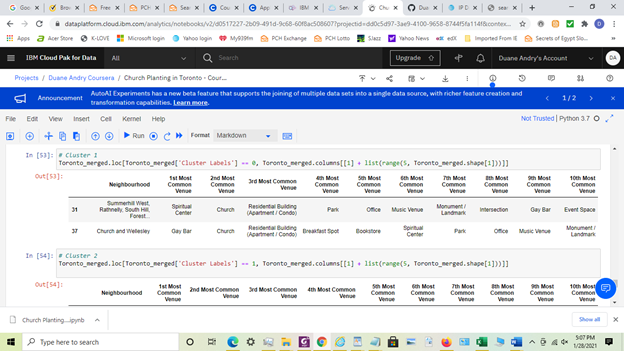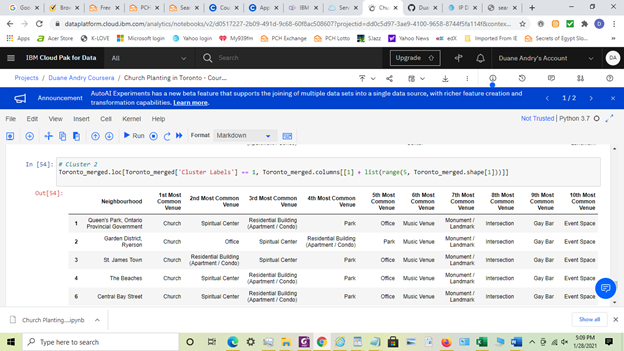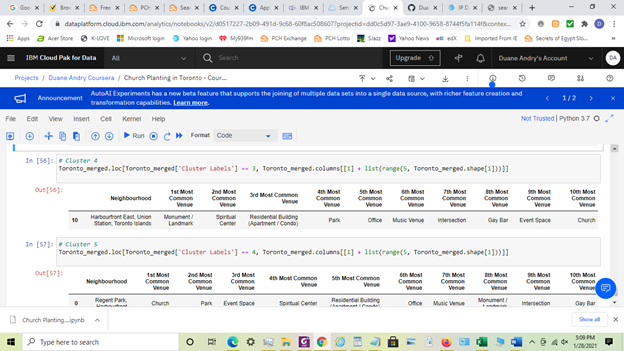Spiritual Site Planning in the 21st Century
Purpose
The topic that we are interested in exploring is this: Spiritual Site Planning in the 21st Century. We have prepared documentation of a Machine Learning methodology that can be applied to neighborhood clustering, to give insight into an optimal planting of a new religious outreach. For purposes of the study, we selected the planting of a new Christian church.
Please note that this document only describes the first stage of site selection, which is this: to determine whether there is a practical, spiritual need for a house of worship of a particular type in a particular locale. The report is intended to satisfy these three parts of the preliminary site selection process: as a proposal, as a procedure and as a proof of concept.
- As a proposal, it gives an option for the first stage.
- As a procedure, it involves manipulation and tailoring to fit the unique theological place of worship that is being considered. As such, it will require a follow-on project to identify the parameters that need to be input to the process and the appropriate use of parameters at the front-end of the process; one of which is the type of religious establishment (for instance, Christian, Prayer room, and others).
- As a proof of concept, it uses the boroughs of Toronto, in Canada, to show the type of deliverable that can be expected, while also giving further information on the evaluation that will be required after this processing is done.
In addition to this blog post, it is composed of the following other parts of supporting documentation:
- Report on Spiritual Site Planning in the 21st Century: https://github.com/Duane2DS4Andry/Coursera_Capstone/blob/master/The%20Battle%20of%20the%20Neighborhoods.pdf
- Python notebook showing the Machine learning that is applied to this discipline: https://github.com/Duane2DS4Andry/Coursera_Capstone/blob/b56fa2b3aeb63e770d8c7bd6c63ff5cd7ed24039/Church%20Planting%20in%20Toronto%20-%20Coursera.ipynb
We hope this provides the Spiritual site planning / planting specialist with a potential tool for development of future religious outreaches.
—————————
Spiritual Site Planning in the 21st Century
Introduction
This is a proposal that is targeted to Church / Houses of Worship planners. It is intended to provide first level information about the current places of worship: information that can be used to identify a candidate location for installing a new community-based religious outreach. To do this, it is necessary to come to a balance between honoring existing ministries, while also being aware of the need for a different perspective to serve a larger and more diverse audience. Specifically, there are two principles that originated in the Christian Bible which are informative in explaining the challenge of being true in selecting a site location.
Consider the following that comes from the Bible, in Romans 15:20-21:
Yea, so have I strived to preach the gospel, not where Christ was named, lest I should build upon another man’s foundation: But as it is written, To whom he was not spoken of, they shall see: and they that have not heard shall understand.
This challenges the planner to select a site that has a need for the theological emphasis of the house of worship being designed. It is not necessary that there be no existing structures of that theological persuasion; but it does indicate that there should be some level of additional need, where there is already some support. Of course, ideally, the planner will locate a ‘virgin’ site.
Also consider the following that comes from the Bible, in the first epistle of Paul the apostle to the Corinthians 9:19-23:
For though I be free from all men, yet have I made myself servant unto all, that I might gain the more. And unto the Jews I became as a Jew, that I might gain the Jews; to them that are under the law, as under the law, that I might gain them that are under the law; To them that are without law, as without law, (being not without law to God, but under the law to Christ,) that I might gain them that are without law. To the weak became I as weak, that I might gain the weak: I am made all things to all men, that I might by all means save some. And this I do for the gospel’s sake, that I might be partaker thereof with you.
This challenges the planner to select a location that has more than the single theological focus of the site plan. This is necessary because one of the strongest purposes of building a house of worship is to interact with others who have a mind to serve God. This means that there is a necessity for communication of the message that brings the overseers of the house of worship (pastor, priests, bishops, etc.) to this location. This is the process that includes proselytizing. So, in the surrounding environment of the proposed house of worship, there needs to be other type of theological persuasions (temples, prayer rooms, etc.)
This is the challenge that leads us to use modern data analysis and machine learning methods, to extract insights from existing information about boroughs and neighborhoods. For purposes of illustration, we will look at the Toronto, Canada area.
—————————
Spiritual Site Planning in the 21st Century
Data
To recap, from the introduction, we stated the following: this is the challenge that leads us to use modern data analysis and machine learning methods, to extract insights from existing information about boroughs and neighborhoods.
In this study we will manipulate the following resources for location information, as indicated:
-
Scrape the following Wikipedia page, https://en.wikipedia.org/wiki/List_of_postal_codes_of_Canada:_M , in order to obtain the data that is in the table of postal codes and to transform the data into a pandas dataframe. The dataframe will consist of three columns: Postal Code, Borough, and Neighbourhood. For example:
Postal Code Borough Neighbourhood
4 M5A Downtown Toronto Regent Park, Harbourfront
-
Additional information will be obtained by utilizing the following link to a csv file that has the geographical coordinates of each postal code: http://cocl.us/Geospatial_data . An example of the information that is needed from there is shown below:
Postal Code Latitude Longitude
2 M1E 43.763573 -79.188711
We will also need information on the existing houses of worship. This type of information is contained in what are known as venues. One of the premier locations for obtaining borough and neighborhood venue information is Foursquare. This is the place where we will search for the necessary information about existing houses of worship. The level of data that is needed include more than just the borough and neighborhood of the house of worship. We must also be able to extract the theological focus of the houses that are contained in those location.
Once we have obtained this collection, we will be able to apply machine learning to order the information in ways that allow us to see patterns of need in the various locations. That need will be based on the specific type of house of worship for which we are planning.
On the following page, there is a screenshot of some of the information that is provided in the Foursquare offering.
Foursquare Sample Categories

We will have more to say about the use of this information in the Methodology section of the report.
—————————
Spiritual Site Planning in the 21st Century
Methodology
To perform this analysis, the first thing that must be done is to prepare a pandas dataframe of Toronto entities and their addresses, with their associated latitude and longitude values. To get this information we gather the following columns of data:
-
From https://en.wikipedia.org/wiki/List_of_postal_codes_of_Canada:_M , we obtain the following data that is in the list of postal codes:
Postal Code Borough Neighbourhood
4 M5A Downtown Toronto Regent Park, Harbourfront
From
http://cocl.us/Geospatial_data we obtain the geographical coordinates of each postal code, for example:
Postal Code Latitude Longitude
2 M1E 43.763573 -79.188711
To use the geographical coordinates of each postal code, we need to remove the “Not Assigned” Boroughs, since the “Not Assigned” postal codes are not in the listing.
Now, we join two collections of information to make the following type of rows of a dataframe:
Postal Code Borough Neighbourhood Latitude Longitude
4 M5A Downtown Toronto Regent Park, Harbourfront43.763573 -79.188711
Once the above join is done, we drop the postal codes from the pandas dataframe, since we will be working primarily with Boroughs and Neighbourhoods. The following is an example of the resultant dataframe, for all Canada Boroughs.
Borough Neighbourhood Latitude Longitude
4 Downtown Toronto Regent Park, Harbourfront43.763573 -79.188711
From the above dataframe, we extract only those rows that contain the word “Toronto” in the Borough. This is our candidate set for further processing. This is the set that will be parsed through an Internet offering known as Foursquare. A brief description of that offering is included below, from the Foursqure.com “About Us”.
“It all starts with the data – and ours is unmatched in quality and depth. We combine the rich attributes of over 105 million global points-of-interest with the understanding of human movement from over 500 million devices, including a persistent first-party panel.”
Now, we use the Foursquare API to explore neighborhoods in Toronto. We use the explore function to get certain spiritual venue categories in each neighborhood.
Then, we take the venues list, and group the neighborhoods into clusters: to do this, we use the k-means clustering algorithm to complete this task. As described on the Internet: “This algorithm is an iterative algorithm that partitions the dataset according to their features into K number of predefined non- overlapping distinct clusters or subgroups. It makes the data points of inter clusters as similar as possible and also tries to keep the clusters as far as possible.”
This tool allows us to order locations by their predominant houses of worship, then produce clusters of neighborhoods that may benefit from a particular offering of religious outreach. By evaluating these clusters, we will be able to identify places that meet the two principles of religious site planting:
- “Yea, so have I strived to preach the gospel, not where Christ was named, lest I should build upon another man’s foundation.”
- “For though I be free from all men, yet have I made myself servant unto all, that I might gain the more.” . . . “I am made all things to all men, that I might by all means save some.”
We only select the top ten unique sites for further evaluation. Please note that some of the neighborhoods will not have any spiritual sites that match our top ten selection criteria; so, first we remove neighborhoods that do not have any representative spiritual sites. This is done by removing any rows that have NaN in the label (‘Cluster labels’) that identifies the collection to which each neighborhood belongs.
Finally, we will use the Folium library to visualize the neighborhoods and their emerging clusters.
We deployed all these tools in a python notebook that we push to GitHub. We will have more to say about the deliverables from this notebook in the following section: Results.
—————————
Spiritual Site Planning in the 21st Century
Results
The following shows the clusters of neighborhoods, in two images.
—————————
Firstly, here are screen prints of all or a portion of the cluster collections that are notable as potential sites.
Cluster One

Cluster Two

Cluster Three

Cluster Four

Cluster Five

—————————
Shown below, there is a visual representation of the cluster collections:

—————————
Also of interest is this collection of neighborhoods that do not contain any representative venues, and that, therefore, do not fit in any of the collections. We are including them here for the sake of completion of the report on boroughs and neighborhoods in Toronto.


—————————
Note: for the partial collections, their full depth can be seen in the notebook associated with this report.
—————————
With this information, we can take a good look at the results, in the neighborhoods clustering of the python notebook, to perform the two-fold evaluation of the sites that will give us a candidate location for our religious offering. This, we will do in the next section: Analysis.
—————————
Spiritual Site Planning in the 21st Century
Discussion
To satisfy principle one, we will evaluate the clustering of neighborhood to determine a cluster that does not have either a predominance or a prominence of our intended site of worship. For purposes of our evaluation, here, we will look for a site that would support the planting of a Christian church.
If more than one location satisfies principle one; then, to satisfy principle two, we will evaluate the selected cluster individually, from the collection of clusters, to locate a neighborhood that has the greatest breadth of other offering of religious outreach.
Considering the Results itemized in the prior section, as applied in its use for placement of a Christian church, we deselect cluster four (4), since its label seems to indicate that it is not a residential section of Toronto.
From the clusters that remain, we deselect ones that have a predominance or prominence of “Church”; for instance, where it is in the first position. These are clusters two (2) and five (5).
From the remaining clusters – one (1) and three (3) — we have chosen from cluster one (1) and the neighborhood on row 37:

In this neighborhood, we see that “Church” is not the first venue identified, but, nonetheless, there are other locations that are churches. Also in this neighborhood are venues that provide for further outreach because they are not churches. This meets the two-fold dynamic of religious site planning, as it pertains to a Christian church, which we described in the reasoning for site selection. Also, as we look further into the cluster, we see that there is another neighborhood that allow for potential proselytizing in the Christian message. This is the concept of sharing that is an integral part of being a Christian outreach.
—————————
Spiritual Site Planning in the 21st Century
Conclusion
As we have shown, machine learning allows for a robust evaluation of neighborhood components that are germane to church planting. In this report, we have covered the first stage of church planting: site selection. The use of machine learning produces a reusable model that will serve for revisiting the factors that lead us to a particular location, as opposed to other locations.
Machine learning, as done in this study, shows us the cluster of neighborhoods that can benefit from the offering of services in our current portfolio of outreach potential. Thus, it serves to allow the maximization of assets, to produce the best outcomes for the impacts that we can make. Moreover, there will be opportunities to evolve our portfolio, to include other services. In that respect, it is an organismic approach to worship offering.
We also need to consider the condition where there is no need for evolution in our portfolio of services. This does not mean that we can discard the tool when we have maximized the provision of service. Another factor that must be considered is neighborhood change itself. This tool can be utilized, from time to time to support the redeployment of resources as needed, as the dynamics of the neighborhood cluster changes. For instance, at such times as additional organizations enter the cluster of neighborhoods, or entities remove themselves from service in this area, we can reevaluate the environment without changing this tool that originally brought us to this place of service.
Reuse of the tool is the power of employing machine learning to the environment, to provide insight into our place (or not) of service therein.